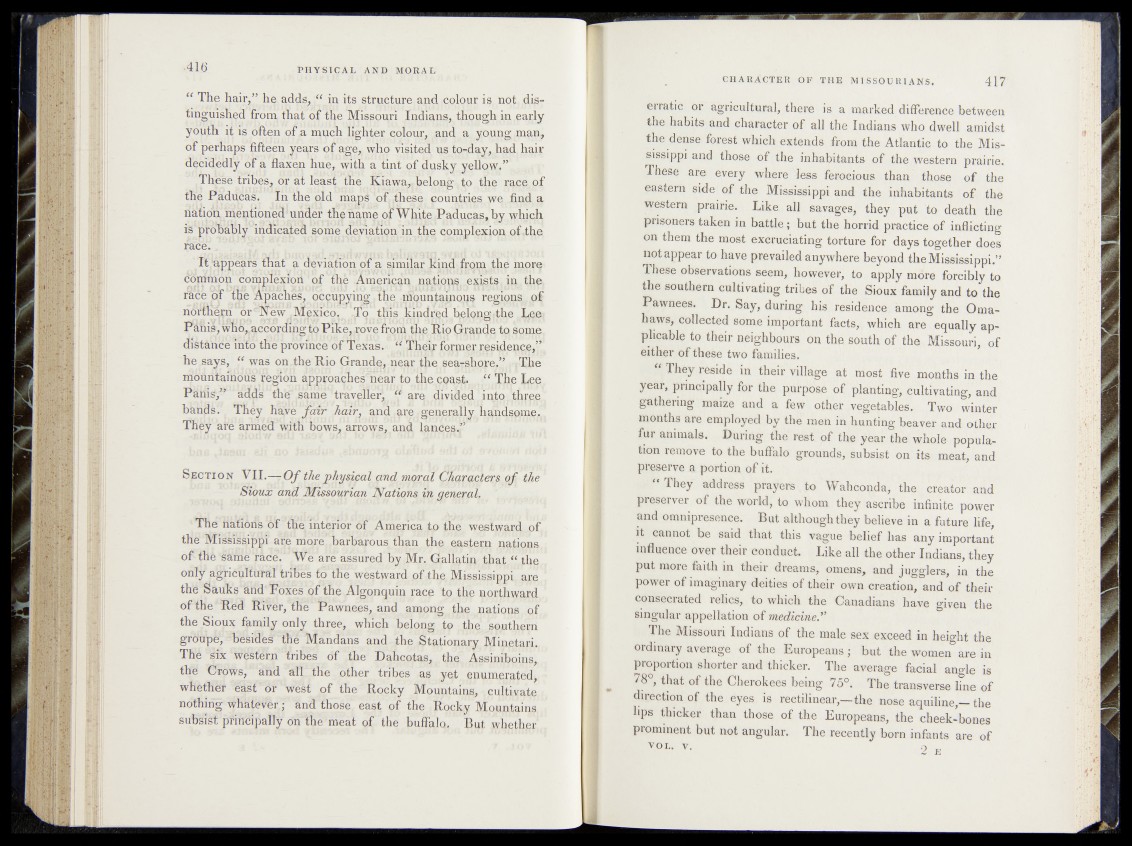
K Thehair,” he adds,;“ in its structure. ^nd|Rolour, i§0npt!A^ -
tinguis^d t^at o^tne Missouri Indians, though in early
3fo$h it Is ofteng ffr Iighfer colour, .and a.s youpgjmatp,
ofperhaps*fifteenyeare^of age^ who yisitea us^to*4%y, had, hg.ii:
'aêcïdèdly or ,a flaxen hue,' with a tint of ^usky^eÜWt” **,
These frites. Or at least the Kiawa,|heiong^to, Ahe race of
fbe Phducas. In the old map! offi|tes| coüqJ^èa^e,.j|^.&
liafio^me^trbn^un^er the name of Whit^Pedu^ap^by Ayhjqh
is PI’ODaply'inaicE^ea some^dWiation in the completion, of »tb^e
race.jf'
I t(^b|)%rs‘ that a deviatipn or a similar Mind, from Jh(i
coirimpnjco^mexrpn 'of fhe .American natioras ex^|ss in flies
rac^ o r T? Apaches, occupying »the mountapiqus region ^ of
northern Or'^ffew .Mexico^ .To. tMs kincfrfed hel^Qg^e
Panis, wno^ccoVdmg Pike^joy e Frpni tpe Rtio (xrande to some
distance mfo the province of T é x a i L i . / / former Yepiden^jj’
he „says, c‘ was on „the Rio Grande. near tjie sea^shoTe.y.jn The
mountafnbus re^oh apppachesmear toAhe c©asLr “ The Lee
PdtiiS, u ad^ts th^.same^traveiler^ ¥ am divmedlinto three
hands. Tnéy ha,ve f a i r h a ir , and gre |'^neranydmpdsrmmir
They are anffed with bows, arrows, and lanOes^’
Section VII.— O f the p h y s i c a la n d m o r a l Ch$racte%s of* the ’
$ io u x a n d M h so u r ia n j^ a tio ris in general^
‘p e tfapffs of Jtife. mtenor’ the w ^ p e rd pfn
thè1 M lllji|i|p f a"ra m r n ^ a r t ^
oT fhê jM i e r a c t r w e are assured by Mn iji^ t/f the f ]
^&i6vKiffartntes to the westward pf ;the Mississippi are |
thé Snuhs^dnd!ï^ x e s ‘óf th e ,Algonquin race to ttö nprthyra,rd
of th em e d Iffiver, me Pawnees, and among the nations o f !.
the Sioux family only three, which belong t? . th e spnthern
g rW J ^ ^ é è t S ^ ^ e ^ ^ d a n s and the Stationary Minepi'i.,
Tfté -lig:*WÉfern " tribes Of the Dahcotas, the Assinifloins,
thd Grotvs, ahd all .the other tribes .as yet enumerated,
whether M M fW wesi of the Rocky Mountains, ’ cultivate,.
nothing whatévl&r f and f h o p east pf the 'Mmjntainf
subÖièt'pfihÖipalTy ori‘ihe4meat of the buffalo. But whether!
CHARACTER OF THE MISSOURIANS. 417
erratic or'agricultural, there is a marked difference between
the habits- and character of all the Indians who dwell amidst
the- dense forest which extends from the Atlantic to the Mississippi
and those of the inhabitants, of the western prairie.
These are every wherefess ferocious than those of the
eastern side of the Mississippi and the inhabitants of the
western prairie. Like all savages, they put to death the
prisoners taken in battle; hut the horrid practice of inflicting
on them the most excruciating torture for days together does
not appear to have prevailed anywhere beyond the Mississippi.”
These observations seem, however, to apply more forcibly to
the southern cultivating tribes of the Sioux family and to the
Pawnees. Dr. Say, during his residence among the Oma-
haws, collected some important facts, which are equally applicable
to their neighbours on the south of the Missouri, of
either of these two families.
| They reside in their village at most five months in the
year, principally for the purpose of planting, cultivating, and
gathering maize and a few other vegetables. Two winter
months are employed by the men in hunting beaver and other
fur animals. During the rest of the year the whole population
remove to the buffalo grounds, subsist on its meat, and
preserve a portion of it.
They address prayers fo Wahconda, the creator and
preserver of the world, to whom they ascribe infinite power
and omnipresence. But although they believe in a future life,
it cannot be said that this vague belief has any important
influence over their conduct. Like all the other Indians, they
put more faith in their dreams, omens, and jugglers, in the
power of imaginary deities of their own creation, and of their
consecrated relics, to which the Canadians have given the
singular appellation of medicine*’
The Missouri Indians of the male sex exceed in height the
ordinary average of the Europeans; but the women are in
proportion shorter and thicker. The average facial angle is
J8°, that of the Cherokees being 75°. The transverse line of
direction of the eyes is rectilinear,—the nose aquiline,—the
lips thicker than those of the Europeans, the cheek-bones
prominent but not angular. The recently born infants are of
V0L> v- 2 E